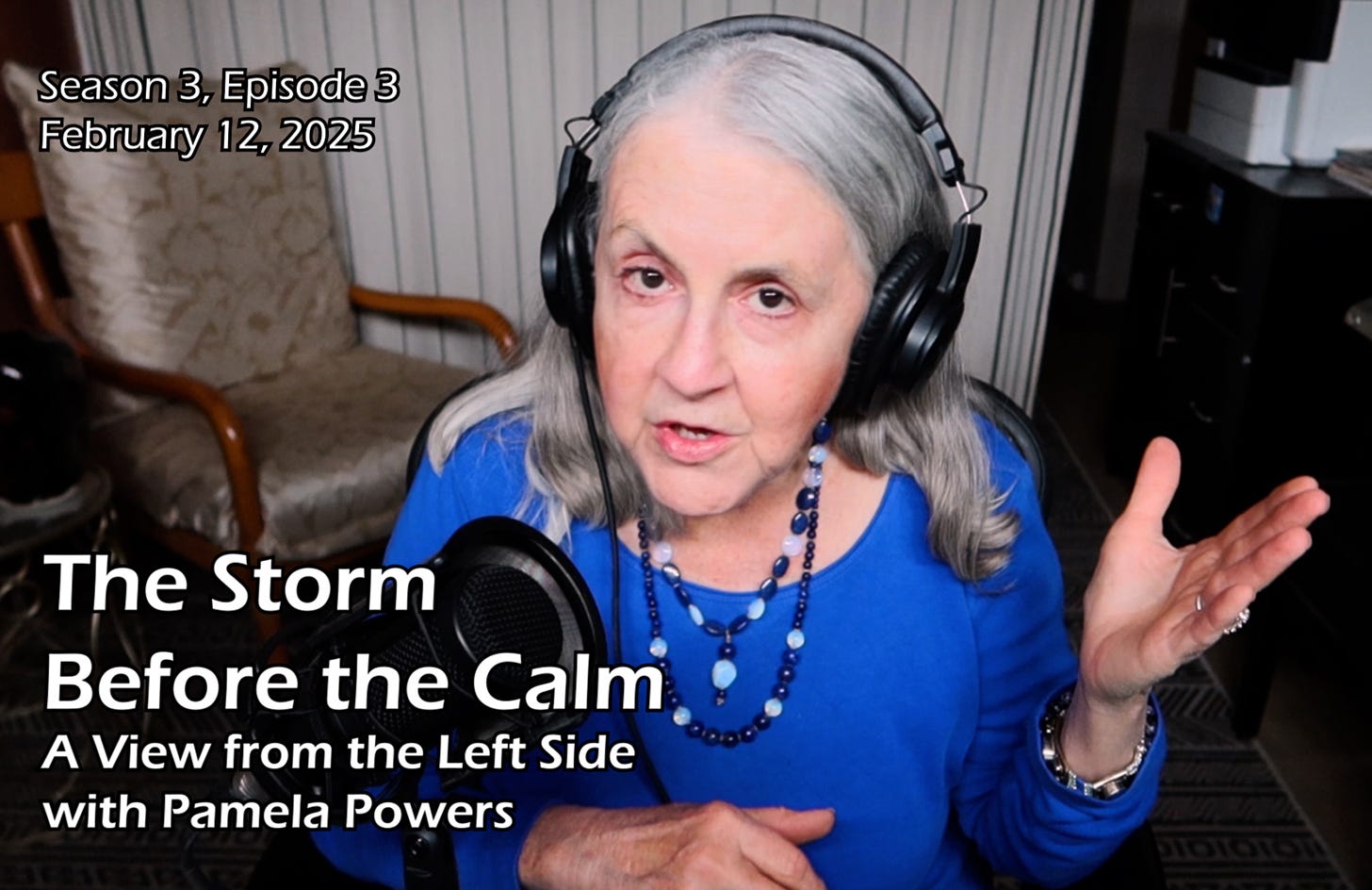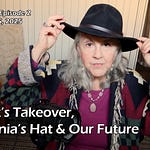The title of this podcast, The Storm Before the Calm, is taken from a book by George Friedman, founder of Geopolitical Futures.
A good friend of mine gave me this book for Christmas. Initially, I balked at the title. I was not eager to read about “the storm” since we have been living in the eye of a hurricane since January 20, 2025, when Donald Trump took office. The last thing I wanted to do was read anything about Trump.
One evening in January when even the comic pundits were too depressing to watch, my choice was another murder mystery or The Storm. I tackled The Storm, and it’s a great book—very insightful. I love the long-view historical perspective.
Yes, Trump is in the book, but he’s not the storm. We’re the storm.
Today, we’ll be talking history, economics and institutional and socioeconomic cycles. Friedman writes that the US has two predictable cycles that date back to the "invention" of the country by the Founding Fathers: the 80-year institutional cycle and the 50-year socioeconomic cycle. Think of them like the tectonic plates shifting before an earthquake.
At the end of each 50-year economic cycle, there is division and great upheaval in the country and "it's as if the country is tearing itself apart," Friedman writes.
Sound familiar? That's where we are today. I was surprised -- and somewhat dismayed but oddly relieved -- to find out that in this decade both of these cycles will shift. Two earthquakes. In 2020, Friedman said that 2025 would be a pivotal year. Well, here we are!
Here is a link to the A View from the Left Side (AVLS) podcast website, where you can see all of the segments and hook up with AVLS via your favorite podcast network. A View from the Left Side is on multiple podcasting services such as Apple Podcasts, Spotify, I Heart Radio, Podcast Index, Podcast Addict, Pocket Casts, Deezer and others. YouTube podcast videos and original Legislative update videos can be found on my YouTube Channel and Substack.
Podcast Time Stamps
| We Are the Storm | 0:21
| Don't Worry. It's Just a Phase. | 1:48
| Cycling Through US History | 8:14
| The Rise of Feminism | 11:45
| Backlash in the 21st Centruy | 14:05
| Tired of the Trickle-Down | 19:33
| Common Themes Throughout Our History | 25:00
Shifting Cycles and the ‘Failed President’
The signals of a shift to a new socioeconomic cycle are: great discontent among the people, broken or obsolete economic systems, and a "failed president" at the end of the cycle. This president is elected during the social unrest and upheaval but uses old ideas and old models to solve current problems.
Clinging to old models doesn't work and often makes the situation for the people worse. A classic example is President Herbert Hoover clinging to the old models and ignoring the plight of millions of hungry and impoverished Americans. The Great Depression got worse during his term.
Hoover was the "failed president" at the end of that cycle and President Franklin Roosevelt was the first president in the new cycle. Roosevelt made sweeping changes to the federal government to tackle the Great Depression, to feed people and put them back to work, build infrastructure and fight fascism in World War II. President Lyndon Johnson built on the New Deal with the Great Society.
The middle class and the union movement grew during the Roosevelt cycle. Thanks to federal programs, many people became homeowners and college graduates. And the rich paid taxes. President Jimmy Carter was the "failed president" at the end of that cycle.
Are these Waning Years of Reaganomics?
Currently, we are in the waning years of the cycle that began with the election of President Ronald Reagan. He infamously introduced us to "trickle-down" economics, an economic policy that never worked. The theory is that dramatically cutting taxes on the rich would lead to "trickle-down" wealth. Making the rich richer was somehow supposed to enrich the masses. The people of the United States have been suffering under this failed model for decades.
Thanks to 50 years of Reaganomics, the wealth gap in the US is wider than ever, the billionaires are becoming trillionaires, corporate welfare is running rampant while people are hungry, the middle class has shrunk, the cost of housing, automobiles and college tuition are threw the the roof, homelessness is rising, BUT politicians continue to cut taxes for the rich and ignore the rest of us.
Politicians are clinging to trickle-down economics -- a 50-year old, failed economic model -- to fix the problems that trickle-down economics caused. That won't work.
Is Trump "failed president" of the Reagan socioeconomic cycle — the trickle-down era? The Trump/Musk regime is clinging to the past on multiple fronts, but they want to go back to 1890 — not 1980.
The billionaires want to keep their tax cuts and lucrative government contracts with no oversight. They don't want to go back to the Hoover era. They want to go back to the 1890s when the robber barons were in charge of the government, and President William McKinley did their bidding. Sound familiar?
The right has their plan to take us backward—Project 2025. (I don’t think it is a coincidence that their book is named for the year Friedman predicted dramatic change — but not what that would be. The Storm was published before the 2020 election.)
They have a very detailed plan, and they are racing through it. It hasn’t even been a month since the inauguration!
What's our plan?
The Storm gives us insights regarding where our country is now, how we got here and where the current government chaos is taking us.
‘The Storm’ Podcast Text
[This is the text of the podcast — not a transcript. The podcast delivery has a few improvisations — like when I tell Kamala Harris that she should have called me.]
Season 3, Episode 3 of a View from the Left Side – The Storm Before the Calm-- was recorded on February 12, 2025.
Segment 1: We Are the Storm
Hello, I’m Pamela Powers of Powers for the People. Welcome to my podcast, A View from the Left Side.
The title of this episode – The Storm Before the Calm—is taken from a book by George Friedman, the founder of Geopolitical Futures. A good friend of mine gave me this book for Christmas.
Initially, I balked at the title. I was not eager to read about “the storm” since we have been living in the eye of a hurricane since January 20. The last thing I wanted to do was read anything about Donald Trump.
One evening in January when even the comic pundits were too depressing to watch, my choice was another gruesome murder mystery or The Stom. I tackled The Storm, and it’s a great book—very insightful. I love the long-view historical perspective.
Yes, Trump is in the book, but he’s not the storm. We’re the storm.
Today, we’ll be talking history, economics and institutional and socioeconomic cycles.
The Storm gives us insights regarding where our country is now, how we got here and where the current government chaos is taking us.
Segment 2: Don’t Worry. It’s Just a Phase
The Storm begins with the original European adventurers and settlers who came to America and discusses in detail the political, economic and social forces that have shaped the US throughout our history.
Governments and countries go through natural life cycles. When the current systems stop being effective and begin to break down, dramatic change is necessary to fix or replace the outdated systems. According to Friedman, the United States “regime” has two very predictable cycles—the 80-year institutional cycle and the 50-year socioeconomic cycle.
“The institutional cycle controls the relationship between the federal government and the rest of American society … The socioeconomic cycle … alters the dynamic of the American economy and society,” Friedman writes. The US experiences political upheaval and societal unrest whenever one of these cycles shifts—kind of like earthquakes when the tectonic plates shift.
Our first institutional cycle began in 1787 with the drafting of the US Constitution, shortly after the Revolutionary War ended. It lasted approximately 78 years. During that time, war, invention, ingenuity, slavery, immigration, the Hamiltonian Bank and more land transformed the 13 colonies into a vast, united country with an infrastructure.
Friedman credits Thomas Jefferson (a “philosophical genius” and “small d” democrat), John Adams (a “legal genius” and a Federalist) and Ben Franklin (a “genius at living” and an iconoclast) with being the most significant Founding Fathers. These three “invented” the United States “regime”.
The Declaration of Independence promised “life, liberty and the pursuit of happiness." The framers of the Constitution created a government with three equal branches – executive, legislative and judicial— and a system of checks and balances. The voters and this system of equal branches regulating each other was set up to keep the government going, protect the republic and prevent the rise of a monarchy.
Although I knew that both Jefferson and Franklin were inventers, I had never thought of the United States and our government’s structure as being inventions. Throughout the book, Friedman highlights the role of inventors, inventions, technology, and science in our nation’s history.
The United States didn’t exist before the Constitution and the election of President George Washington. Most other countries are centuries old, and their people have long familial roots, a common language and a shared history.
In contrast, we are a country of immigrants with many cultures, languages and religions, and we live in states that have their own cultures, politics, geography and resources.
That’s a lot of diversity for a country whose current government is trying to deny the contributions of immigrants.
But I digress…
Although the Founding Fathers and the original voters were primarily White Anglo Saxon Protestants (WASPs), the founders did consider the economic and geographic diversity of the states, when they tried to balance power between Northern industrial states, dotted with small towns and family farms and Southern agrarian states, with large plantations that relied on slaves. The steady stream of immigrants helped fill our country’s need for industrial workers, farmers, soldiers and settlers.
Franklin and Jefferson decided the US needed a unifying symbol to bring the 13 distinct colonies together into one new country. The Great Seal of the United States of America is sort of a graphic pep talk on unity: We’re all in this together.
The first Secretary of State created Great Seal of the United States. The seal is packed with symbolism. It features the bald eagle (one of the largest birds of prey in the US) with an olive branch in his left talon and 13 arrows of war in his right talon. In his mouth is a banner that reads E pluribus unum (“Out of Many One”). The reverse side of the seal features an unfinished pyramid – symbolizing that our country is a work in progress-- with the Eye of Providence (an eye inside of a triangle) above it. The inscriptions on the back side are Annuit coeptis (“He has favored our undertakings”) and Novus ordo seclorum (“A new order of the ages”). Pretty heady stuff for a ragtag group of 13 colonies who were very different from each other … and still are.
Segment 3: Cycling Through US History
The first institutional cycle of the US was one of creation and expansion.
Leading up to the Civil War, there was great strife and division in the US. For decades, abolitionists in free states like Ohio openly defied the federal government and helped slaves escape to Canada by way of the Underground Railroad. There was a moral tension in a country that preached “life, liberty and the pursuit of happiness” but considered African slaves to be subhuman (three-fifths of a white man).
In the South, slaves were property, and free labor was an integral part of the plantation economy. In the North, which was dotted with small towns, abolitionist ministers of the Second Great Awakening preached that slavery was against the will of God and, therefore should be abolished. Ohioans also believed that their free-state constitution superseded federal government laws like Fugitive Slave Act. (These two anti-slavery arguments should sound familiar. “That’s against my religion” and “this is a states’ rights issue” are arguments we hear today.)
The second institutional cycle began in 1865 after the end of the Civil War and drafting of the 13th, 14th and 15th Amendments to the Constitution—the abolition of slavery, the initiation of birthright citizenship and the right to vote regardless of race. It lasted until 1945 and the end of World War II.
After the upheavals of Great Depression, the rise of fascism, the reforms of the New Deal and WWII, the third institutional cycle strengthened the federal government. The New Deal programs that shaped the economy and society – like the jobs programs, food stamps, the minimum wage and Social Security -- were continued.
President Lyndon Johnson and his all Democrat Congress built upon those structures during 1960s with the War of Poverty, Civil Rights Act, the Voting Rights Act, the establishment of a permanent food stamp program and the creation of Medicare, Medicaid, and HeadStart. (Sixty years later all of these programs are under attack by the Trump administration.)
Rev. Martin Luther King, Jr. and his nonviolent civil rights movement exposed racism in the US and pushed Johnson and the Democrats to change the laws. Alongside the civil rights movement, in the 1960s and 1970s, we saw the rise of the anti-war movement, feminism, gay rights, labor unions, Black Power and environmentalism. People wanted change.
Segment 4: The Rise of Feminism
Friedman credits American women factory workers – not the warrior men – with winning WWII. Hundreds of thousands of women – many of whom had never worked outside of the home—donned overalls and went to work in factories building ships, tanks and the machinery of war.
What was their reward? All of them were fired when the men came back from World War II. It’s not surprising that we saw the rise of feminism after that.
During the third institutional cycle, the invention of the birth control pill, the legalization of abortion, the sexual revolution, the passage of the Title IX laws to prevent sex discrimination in education and employment and the creation of the Equal Employment Opportunity Commission (EEOC), to enforce the anti-discrimination laws – all dramatically changed in the lives of women in the US.
Historically, the woman’s role in society and the family was to have an many children as possible, even if she died trying. With birth control and access to abortion, an American woman, in the modern age, could choose how many children she had. Instead of having eight or more children and spending her entire life caring for them, a woman could choose to have one or two children – or none—and have a life outside of the home. With advances in birth control and medical care, instead of having a life expectancy of 40, American women now have a life expectancy of nearly 80.
World War II’s Rosie the Riveter showed her daughters and granddaughters that they could have a different life with a job and independence. The changing role of women over the past 50 years has changed relationships, family life, child-rearing and marriage. Men have not adapted well to this new realty. The current backlash against women and our rights isn’t a smart long-term strategy. The old system is broken and needs to change.
Segment 5: Backlash in the 21st Century
Preceding the end of each socioeconomic cycle there are years of great upheaval and social unrest. It’s as if the country is fighting against itself during these time periods, Friedman writes. People are frustrated and angry because the old systems are broken and need to be replaced, but people in power cling to old strategies and deny there are problems. Does this sound familiar? We certainly heard this during the 2024 election cycle—with the Democrats telling us everything is fine and Kamala Harris saying there’s nothing she would do differently.
In 2020, Friedman wrote that if the 80-year institutional cycle continues to be predictable, the fourth cycle will begin around 2025 [Yikes!] and “will redefine the relationship of the federal government to itself.” Unfortunately, according to Friedman, we’re facing a double-whammy this decade because the 50-year socioeconomic cycle is also supposed to shift.
Interestingly enough, a “failed presidency” is the signal of the end of a socioeconomic cycle, according to Friedman. The last failed president in a cycle is elected during the upheaval and tries to use obsolete strategies and broken systems to solve the new problems.
Clinging to the past, of course, doesn’t work. Change finally comes with the next presidential election, which begins a new socioeconomic cycle. I think these cyclical patterns are fascinating. Let’s take a trip down memory lane.
The first 50-year socioeconomic cycle began with President George Washington and ended with President John Quincy Adams, the son of President John Adams.
The second cycle began with President Andrew Jackson, the first president of Scots-Irish descent and the first one from west of the Appalachian Mountains, and ended with President Ulysses S. Grant, who was overwhelmed by the financial aftermath of the Civil War.
The third cycle began with President Rutherford B. Hayes and ended with President Herbert Hoover, who was infamously stingy with the unemployed people in the bread lines during the Great Depression. Hoover is a great example of a president using old ideas to tackle a new reality and making everything significantly worse.
The fourth cycle began with President Franklin Roosevelt, who made sweeping government and societal changes to tackle the Great Depression, put people to work, and defeat fascism, and ended with President Jimmy Carter. Taxes on the wealthy remained high during the fourth cycle. The union movement and the middle class grew. Many people became homeowners and got college degrees thanks to federal government programs.
The fifth socioeconomic cycle – which we are currently in – began with President Ronald Reagan, who championed low tax rates for corporations and the rich. Reagan claimed that their wealth would trickle down and benefit the rest of us. Reagan aggressively cut taxes for the wealthy and started a 50-year trend of widening economic inequality. The middle class shrunk. Work/life balance eludes workers struggling in the gig economy. Poverty and homelessness are steadily increasing. The billionaires are becoming trillionaires thanks to tax breaks and lucrative government contracts. The deficit has ballooned because of decades of tax cuts, most notably, the unaffordable Trump Tax Cut and Jobs Act, passed on a party line vote with no debate during Trump’s first term.
Although the system is obviously broken, Trump’s plan is to continue featherbedding the rich and ignoring the rest of us.
Segment 6: Tired of the Trickle-down
Given the history we just discussed, is Trump the “failed president” at the end of the fifth socioeconomic cycle? Like Hoover, Trump ignoring the current problems of the country and clinging to failed strategies of the past like tax cuts for the rich and deregulation. That’s so 1980.
There’s always unrest toward the end of a cycle.
No one can deny that since the beginning of the 21st century, the US has experienced much upheaval, anger and division related to continuous war, the dot-com crash, the housing crash, the Wall Street crash, the invention of the smart phone, the invention of social media, the invention of gig-economy spot labor apps, the invention of Artificial Intelligence, the COVID pandemic and massive losses in human life, housing and employment related to all of this. This is not life, liberty and the pursuit of happiness.
On top of that strife, the 2010 Supreme Court’s Citizens United ruling, which said corporations are people and money is speech, blew up our elections system. US elections were stupidly long and expensive before 2010, but since Citizens United opened the floodgates, unlimited cash, primarily from nontransparent sources, has flooded our elections. In 2024, crypto currency was added to the dirty money mix. We have the best local, state and federal governments that money can buy. This is a broken system.
In 2011, the Occupy Wall Street movement reminded us that: “We are the 99%” and that “The banks got bailed out, and we got sold out.” Occupy rallied people against greed of the 1%. There were Occupy encampments and marches all over the world. Activists used social media to communicate and to organize. In 2016 and 2020, Senator Bernie Sanders shocked the political establishment by telling voters that the US system is rigged against us. He’s right! He also shocked the establishment by refusing big money donations and running his presidential campaigns on small donations and people power.
In his book, Friedman says that the turmoil and ill will generated by the 2016 election, the statistical tie between Trump and Hilary Clinton (him winning the Electoral College vote and her winning the popular vote) and the election of Trump are all signs of unrest before the shift in cycles. I contend that Bernie’s popularity in both the 2016 and 2020 races was a sign that people on the left and the right were not happy with the status quo and the establishment candidates.
The billionaires played both sides of the aisle in the 2024 election. They want the costly Trump Tax Cut and Jobs Act (TTCJA) renewed. That will only increase the deficit and make a bad economic situation worse.
Renewal of a massive tax cut for the rich won’t help the people who have lost their jobs or their homes, can’t find affordable housing and can’t pay their credit cards or student loans. The Trump/Musk regime isn’t helping people like that. They’re doing the opposite. They’re creating havoc in our lives. The co-presidents are firing tens of thousands of government workers and deporting potentially millions of undocumented workers. Their cruelty toward the people in need is unprecedented. Hoover looks like a tone-deaf bungler compared to Dr. Evil and Mini-Me.
Throughout our history, at the point of crisis, our country reinvents itself. The transition that clearly illustrates this is when capitalist sympathizer Hoover, who ignored the hungry and homeless, lost to Roosevelt, who built a welfare state and a bureaucracy to feed and employ people during the Great Depression. Roosevelt’s actions represented a dramatic and historic change in policy to address the crisis at hand.
Trickle-down economics created our current problems. It won’t fix them. It is failed and obsolete system.
Our election system based on money, our political system based on two parties and our economic system based on capitalism and greed are also broken systems.
Segment 7: Common Themes Throughout Our History
Besides the recurring institutional and socioeconomic cycles, there are many recurring themes in our nation’s history: war, breakdowns in the banking system, boom and bust economic cycles, scapegoating immigrants, preferential treatment for the wealthy, deal-making and promise-breaking, political opportunism, taking land, violence, fear, discrimination, racism, sexism, hard work, frugality, creativity and invention.
If you look at the repeating cycles and themes, big changes often came with war, immigration or new inventions.
Our country and our government were invented by the Founding Fathers. Our country was built by immigrants and slaves. The creativity of our people gave us a slew of inventions that have changed the lives of people worldwide –steam engines, locomotives, airplanes, telegraph, light bulb, phonograph, automobiles, self-driving automobiles, drones, moving pictures, birth control pills, vaccines, personal computers, the Internet, telephones, smart phones, social media, electrical generation, and more recently artificial intelligence.
Can we invent our way out of our current crisis? Several Silicon Valley inventers backed Trump in the 2024 election, donated money and had front row seats at his Inauguration, but those men aren’t going to save us.
They kissed Trump’s ring because they want to continue the status quo. They want to keep their corporate tax breaks and their lucrative government contracts. They are protectionists who want to keep their privilege and their favored financial positions.
Protectionism and greed breed stagnation – not creativity and invention.
Immigration brings in new people, new ideas, new inventions and fresh creativity.
In the last section of The Storm Before the Calm, Friedman talks about average American’s distrust for the federal government, the technocrats who run it, the universities who educate the technocrats and the news media.
The right has Project 2025 to guide them. The Trump/Musk regime is cranking out executive orders, proposing tariffs, threatening land grabs, backing out of agreements, deleting government information and firing technocrats at a furious pace.
And it hasn’t even been a month since he was inaugurated!
I would LOVE for Trump to be the last “failed president” in the trickledown economics era.
But what’s our plan for the future?
We’ll talk about that in a future podcast.
Thank you for listening to A View from the Left Side today.
For now, this is Pamela Powers signing off.
If you like this podcast, please subscribe, like it on social media, make a comment and share it with your friends.
In the meantime, please take care, be healthy and stay vigilant. See you next time.
Here is a link to the podcast website. You can also subscribe to A View from the Left Side on multiple podcasting services such as Apple Podcasts, Spotify, I Heart Radio, Podcast Index, Podcast Addict, Pocket Casts, Deezer and others. YouTube podcast videos and original Legislative update videos can be found on my YouTube Channel.















Share this post